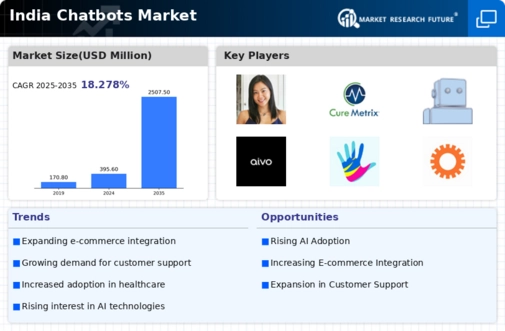Growing Focus on Personalization
Personalization is becoming a key driver in the chatbots market in India. Businesses are increasingly leveraging chatbots to deliver tailored experiences to their customers, enhancing engagement and satisfaction. By utilizing data analytics and machine learning, chatbots can provide personalized recommendations and responses based on user behavior and preferences. This trend is particularly evident in sectors such as e-commerce and hospitality, where personalized interactions can significantly influence customer loyalty. As companies strive to differentiate themselves in a competitive landscape, the emphasis on personalization is likely to propel the growth of the chatbots market, as more organizations adopt chatbot solutions to meet the evolving expectations of their customers.
Increased Investment in AI Technologies
The chatbots market in India is witnessing a significant increase in investment in artificial intelligence technologies. Companies are allocating substantial budgets to develop and implement AI-driven solutions, including chatbots, to enhance operational efficiency and customer engagement. Recent reports indicate that the AI market in India is expected to reach $7.8 billion by 2025, with a considerable portion of this investment directed towards chatbot development. This influx of capital is likely to accelerate innovation within the chatbots market, leading to the creation of more sophisticated and capable chatbot systems. As businesses recognize the potential of AI to transform customer interactions, the chatbots market is set to expand rapidly in response to these investments.
Advancements in Natural Language Processing
Technological advancements in Natural Language Processing (NLP) are playing a crucial role in shaping the chatbots market in India. Enhanced NLP capabilities enable chatbots to understand and respond to user queries more effectively, thereby improving user experience. As of November 2025, the integration of AI-driven NLP technologies is expected to increase the accuracy of chatbots in understanding context and intent, which is vital for effective communication. This improvement is likely to attract more businesses to invest in chatbot solutions, as they seek to provide seamless interactions with their customers. The chatbots market is thus poised for growth, driven by the continuous evolution of NLP technologies that enhance the functionality and appeal of chatbot applications.
Rising Demand for Customer Support Automation
The chatbots market in India is experiencing a notable surge in demand for customer support automation. Businesses are increasingly recognizing the efficiency and cost-effectiveness of deploying chatbots to handle customer inquiries. According to recent data, the market for customer service automation is projected to grow at a CAGR of 25% over the next five years. This trend is driven by the need for 24/7 customer service, which chatbots can provide without the limitations of human agents. As companies strive to enhance customer satisfaction while reducing operational costs, the adoption of chatbots is likely to become a standard practice in various sectors, including retail, banking, and telecommunications. The chatbots market is thus positioned to benefit significantly from this growing demand for automated customer interactions.
Expansion of Digital Transformation Initiatives
The ongoing digital transformation initiatives across various industries in India are significantly impacting the chatbots market. Organizations are increasingly adopting digital tools and technologies to streamline operations and enhance customer experiences. As part of this transformation, chatbots are being integrated into customer service, sales, and marketing functions. The Indian government has also been promoting digitalization through various initiatives, which further encourages businesses to adopt innovative solutions like chatbots. This shift towards digital solutions is expected to drive the growth of the chatbots market, as companies seek to leverage technology to improve efficiency and customer engagement.


















Leave a Comment